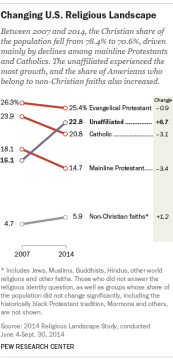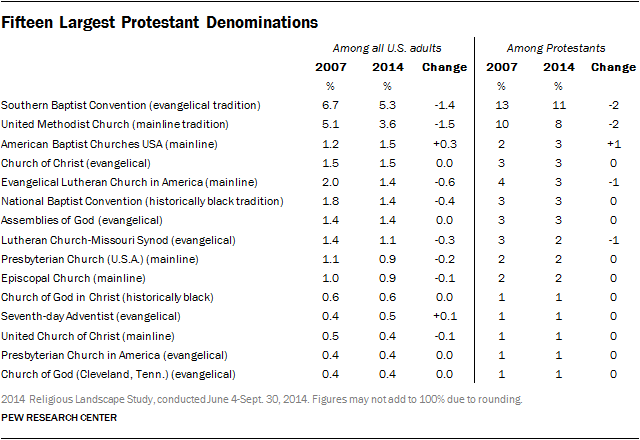
A popular evangelical trope is not as true as some assumed. Regardless, evangelicals would do well to focus on reaching people who are apathetic or antagonistic to the claims of Christianity. (Image courtesy: Mor via Flickr – http://bit.ly/1Ix4SVt)
NEW YORK (RNS) “The collapse of the Protestant mainline has been swift, steady, and self-inflicted,” Southern Baptist Theological Seminary president R. Albert Mohler wrote in 2008.
Mohler’s views align with many of his evangelical colleagues—including Russell Moore just this week—that essentially say liberal theology and politics is responsible for the decline of the once proud American mainline.
But is it really that simple?
According to a sweeping new study by Pew Research Center, the popular evangelical trope is not as true as some assumed. Yes, mainline denominations remain in sharp decline, and yes, evangelicals have fared slightly better overall. Yet many evangelical bodies have begun shrinking as a share of the population as well. Romans Catholics—also theologically and politically conservative—are also declining significantly. This, despite these groups’ evangelistic zeal, orthodox theology, and conservative political stances.
Consider:
- Liberal mainline denominations continue to decline. Over the seven-year period Pew surveyed (2007-2014), these bodies fell 3.4 percent as a share of the total population. But at the same time, evangelical denominations also dropped by approximately 1 percent of the total population. Given that evangelical denominations invest heavily in proselytizing, that can’t be overlooked.
- Mohler and Moore’s own Southern Baptist Convention (SBC), declined as a share of the population by 1.5 percent between 2007 and 2014—even more quickly than evangelicalism at large. The evangelical Assemblies of God, Church of Christ, Presbyterian Church in America, and Church of God failed to grow at all. The only evangelical body among the top 15 largest Protestant denominations that saw any growth was the Seventh-Day Adventists, and they only experienced a 0.1 percent increase as a share of the population.
- During this same time period, among mainline denominations, the United Methodist Church declined by 1.5 percent, the Evangelical Lutheran Church in America declined by 0.6 percent, the Presbyterian Church (USA) declined by 0.2 percent, the United Church of Christ declined by only 0.1 percent, and the American Baptist Churches USA actually grew by 0.3 percent.
- America’s largest “denomination”—the Roman Catholic Church—further challenges the notions conservatives have been peddling. From prohibitions on contraception to resisting same-sex marriage, no body has held the traditional line more than Roman Catholics. Yet between 2007 and 2014, Catholics declined by 3.1 percent as a share of the population.
Simply put, almost all of America’s largest Protestant denominations are declining, regardless of political or theological alignment. Roman Catholics are declining at roughly the same rate as mainline Protestant denominations. The nation’s largest evangelical body, the SBC, is declining at roughly the same rate as the largest mainline denomination, the United Methodist Church.
These numbers tell us that America’s religious landscape is more complex than some evangelicals once believed. Conservatism does not necessarily lead to growth, it seems, and liberalism does not necessarily lead to decline. [tweetable]The waters of change that once overwhelmed mainliners are now lapping at the toes of evangelicalism.[/tweetable]
“If you look at the bigger picture of the evangelical or mainline tradition, we see some decline in both of these shares,” says Jessica Martinez, research associate for Pew Research Center. “Sure, there is a larger decline in the mainline share, but it is a more complicated picture than some assume.”
According to Mike Hout, a sociologist at New York University, evangelicals who want to blame the decline of mainline Protestantism on liberalism are simply not paying attention. He says that population data has always indicated that the mainline decline was mostly attributable to birthrates, a notion he published in an article in the American Journal of Sociology.
“Seventy percent of mainline decline as it was known in those days was due to the fact that evangelical women were having one more child on average than women in the mainline tradition,” Hout says. “This trend prevailed until right around the turn of the [21st] century.”
Hout adds that he believes evangelicals’ greatest weakness is what they’ve championed as their greatest strength: the marrying of political and theological ideology. The rise of the religiously unaffiliated—the “nones,” as in “none of the above”—dates back to 1990 when the Christian right was in full-on combat mode. As conservative bodies became more partisan, members who couldn’t stomach the political agenda waved goodbye.
“Among those who disaffiliated during this period, most were raised in evangelical denominations but were centrist to leftist politically,” Hout says.
The idea that the marrying of conservative politics and theology has had a negative effect on evangelicalism is echoed by Harvard sociologist Robert Putnam and Notre Dame political scientist David Campbell. After surveying various data points, they concluded that moderates and progressives were increasingly leaving the faith as it became synonymous with conservative politics. And because young people aren’t as conservative as their elders, they have led the religious exodus.
“To [Millennials], ‘religion’ means ‘Republican,’ ‘intolerant,’ and ‘homophobic,'” wrote Putnam and Campbell in Foreign Affairs. “Since those traits do not represent their views, they do not see themselves—or wish to be seen by their peers—as religious.”
But according to Martinez, it’s difficult to draw any conclusions about the religious effects of political views from Pew’s latest study; those figures will be released by Pew at a later date, she said.
Triumphalist evangelicals have missed the point. The biggest threat to evangelicals is not some form of liberal faith, but rather faithlessness itself. Most people aren’t leaving evangelicalism for more liberal expressions, but rather for nothing at all.
While conservative Christians were crusading against their more liberal brothers and sisters in the mainline, the real growth has been in neither camp—the share of religiously unaffiliated individuals in America skyrocketed by a whopping 6.7 percent.
Rather than taking pot shots at more liberal strains of Christianity, evangelicals would do well to focus on the threat that all Christians are now facing: the growing number of people who are apathetic or antagonistic to the claims of Christianity.
If evangelicals continue to treat current trends as a race to the bottom, they shouldn’t be surprised if that’s exactly where they end up.







